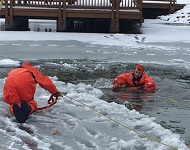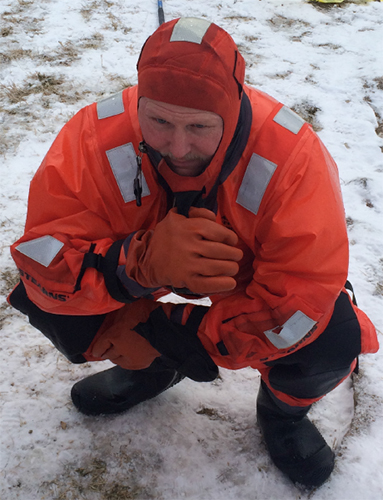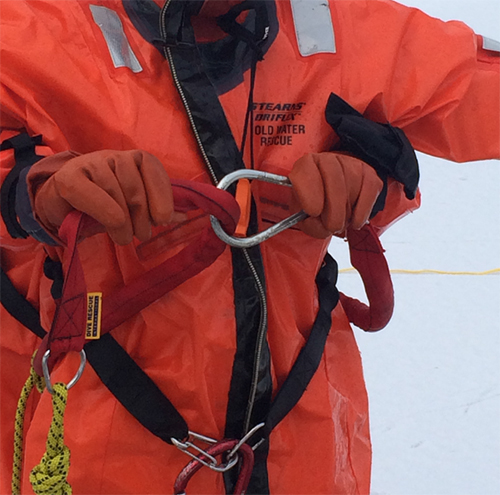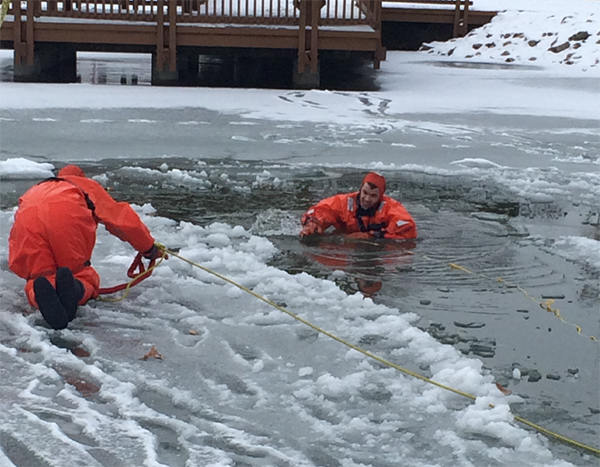
By Brian Zaitz
With the recent massive snowstorm in the Northeast, it is evident that winter is fully upon us. The winter season brings frozen precipitation; cold, northern winds; and freezing temperatures to many. Although some areas are more accustom to this climate than others, the same hazards exist for us all, one being the freezing of lakes and ponds.
These frozen water areas are often seen as “playgrounds” on which to skate or play hockey. However, in an instant, they can transform into rescue scenes with victims falling through the ice into the frigid water below. As an all-hazards industry, we must be prepared for these emergencies, train for likely situations, and plan for our course action.
The normal sequence for water rescues is “Reach, Throw, Row, and Go,” with an actual contact rescue being the last option. However, with ice rescue, the “Go” aspect is often the most practical; the victim is usually hypothermic, confused, and unable to assist in any type of self-rescue. For these reasons, the ability to quickly and efficiently affect a contact rescue is necessary.

After donning the appropriate protective gear, “burp” the suit to release the captured air from the donning process; this affords the rescuer more maneuverability and dexterity in the suit. Even though the victim is hypothermic, communication is still key. Talk with the victim, let him know you are coming to assist him, do not make any sudden movements, and keep eye contact as you move.
RELATED: Zafares and Hendrick on Fall Ice Rescue Preplanning ‖ Kiruski on Ice Rescue Drills ‖ Dummett on Using Airboats in Ice and Water Rescues
It is important to disperse your weight. Do not attempt to walk across the ice; use a crawling or rolling movement to get to the victim—this reduces your risk of cracking the ice and becoming a second victim. As you near the victim, keep your communications and approach from a side and roll in behind the victim. Slide the rescue sling around the victim’s torso and lash it into itself so it cinches and allows the haul team to extricate the victim.

Once in place, give the signal to pull by tapping the top of your head. Once the rescue line is tensioned, begin kicking with your legs and pushing the behind of the victim to lift him up out of the hole and over the ice shelf. The haul team should use caution when pulling to maintain an even pull; jerking or tugging will result in further injury to the victim and rescuer.

Take the time to review all your cold weather procedures and plan and practice how you would perform an ice rescue.
Download this training bulletin as a PDF HERE (3.6 MB)
 Brian Zaitz is a 14-year student of the fire service, currently assigned as the captain/training officer with the Metro West (MO) Fire Protection District. Brian is an instructor with Engine House Training, LLC as well as instructor at the St. Louis County Fire Academy. Brian holds several degrees, including an associates in paramedic technology, a bachelors in fire science management, and a masters in human resource development. Brian is currently and accredited chief training officer and student of the National Fire Academy’s Executive Fire Officer Program.
Brian Zaitz is a 14-year student of the fire service, currently assigned as the captain/training officer with the Metro West (MO) Fire Protection District. Brian is an instructor with Engine House Training, LLC as well as instructor at the St. Louis County Fire Academy. Brian holds several degrees, including an associates in paramedic technology, a bachelors in fire science management, and a masters in human resource development. Brian is currently and accredited chief training officer and student of the National Fire Academy’s Executive Fire Officer Program.
MORE THROW BACK TO BASICS

